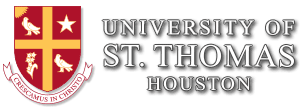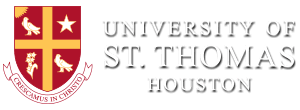Be Bold Blog
The University of St. Thomas (UST) is Houston’s Catholic University, committed to the Catholic intellectual tradition and the dialogue between faith and reason. Our blog is dedicated to helping you explore your future career possibilities and how to make the most of your college experience.
What Is Service Learning and Why Is It So Important?

Whether you know it as service learning, experiential learning, civic engagement, community-engaged learning or another term, the intent remains the same. The goal of service-learning projects is to give students the opportunity to apply classroom theory to real-world problems and give back to their neighbors in a meaningful way.
This kind of program has life-changing potential for students and the communities they serve. To better understand this practice, we gathered expert insight from Dr. Jo Anne Meier-Marquis, associate professor of psychology and director of the Service-Learning Program at University of St. Thomas – Houston (UST). Keep reading to learn more about the key components of these programs and examples of successful service-learning experiences.
First, what is service learning?
Contrary to popular belief, service learning isn’t just a fancy word for volunteering. Service learning is what educators call a “high impact educational practice”—a most effective strategy in getting students involved outside the classroom walls.
“Service learning must be tied to a specific discipline or course,” Dr. Meier-Marquis explains. “It’s an educational opportunity where students can apply what they are learning, see what works and what doesn’t in the real world, and serve the greater community alongside people who have similar goals and interests.”
While participating in service-learning projects, students will go through some version of the following phases:
- Prepare: Students use critical thinking and research skills to better understand the context of their service-learning project. They study the needs of the community they are working with and devise a plan to serve them. Instructors review the plan to ensure the students are addressing a real need in the community and help them come up with an appropriate plan of action.
- Act: Students enact their plan under the guidance of their instructor.
- Reflect: In this critical stage, students have finished their project and are asked to reflect on the experience, both as individuals and as a collective. They are encouraged to interrogate how their own attitudes and behaviors have changed, and how the experience compared to their expectations.
- Assess: The instructor, students and community members evaluate the implementation and outcomes of the project, discuss successes and opportunities for improvement, and share how they feel about what was accomplished.
Types of service-learning projects
There are many different ways to learn through community service. Ideally, students will be given a diverse array of opportunities to put what they’ve learned into action. Broadly speaking, projects can be categorized into the following four types:
Direct: Working directly alongside community members and organizations to address an issue or need.
Examples include:
- Tutoring, mentoring and coaching
- Teaching English as a second language
- Serving meals or distributing food
- Visiting residents at an elder care facility
Indirect: Engaging in work that benefits society at large but does not involve person-to-person contact with community members.
Examples include:
- Building affordable housing
- Volunteering for disaster services
- Working with a nonprofit
- Assisting with environmental cleanup projects
Research: Collecting data and information for the welfare of the public, typically done in collaboration with an existing community organization.
Examples include:
- Conducting surveys to better understand attitudes and beliefs
- Performing research to protect endangered species or environments
- Working in a laboratory to address a community need
Advocacy: Using communication and organizing skills to support or promote a cause.
Examples include:
- Organize a letter writing or call-in campaign
- Gathering signatures for a petition or campaign
- Lobbying on behalf of a marginalized and/or underserved population
- Registering people to vote
Components of a high-quality service-learning program
Because service-learning programs work so closely with the community, it’s essential that the projects are well planned and appropriate for the populations they serve. If you’re excited to start a project of your own, make sure you do your research and choose a high-quality program.
The best kinds of community-engaged learning projects:
- Address a demonstrated need in the community.
- Allow students to practice collective decision making and problem solving.
- Include time for individual and group reflection.
- Give students the chance to apply what they are learning in the curriculum.
- Provide a variety of options that align with students’ diverse skills and interests.
- Are evaluated and assessed for both student and community outcomes and impact.
How students benefit from service learning
As a professor, Dr. Meier-Marquis has built many lasting relationships with former students and reconnects with them periodically. She states that many psychology graduates remember their service learning projects as transformational, even though they might not have been excited to see it on the syllabus at first.
“Once they actually did it, it turned out to be their most meaningful experience during undergrad,”she shares.
A study by the Higher Education Research Institute found that participating in service learning leads to significant positive effects in the most important outcome measures, including:
- Academic performance (GPA, writing skills, critical thinking skills)
- Values (commitment to activism and promoting racial understanding)
- Self-efficacy
- Leadership (leadership activities, self-rated leadership ability, interpersonal skills)
- Choice of a service career
- Plans to participate in service after college
A closer look at service learning at UST
As a Catholic institution rooted in the core values of the Basilian Fathers, UST challenges students to demonstrate goodness by giving of themselves to society. The UST Service-Learning Program’s mission is to assist the University in serving others, specifically offering resources to meet the needs of the Greater Houston metropolitan area.
“It really encapsulates who we are as a university, what it means to serve and be part of a community,” Dr. Meier-Marquis says. In fact, all UST freshman students participate in service learning during their First Year Experience class in the fall. More program-specific opportunities are also available for students as they advance through their college experience.
These initiatives provide chances for students to connect classroom theory with practical experience in the community. This helps instill the importance of civic responsibility in students’ learning.
UST offers many service-learning opportunities. Some examples include:
- Tutoring: Education and child psychology students give individual and group lessons to K-12 students in the local community who need reinforcement in science, math, writing and other subjects.
- Events for local schools: Members of the School of Education help facilitate fun, educational opportunities for local elementary schools, such as Children’s Literacy Night, Super Science Saturday, and more.
- Plant It Forward: Students help tend to the food garden on campus which produces fruits and vegetables to be sold on campus and donated to the greater Houston community.
- Prairie Garden: STEM majors sow, grow and study native plants on campus.
- CELT Food Pantry: Students can help manage a small, free food market on campus, thanks to a partnership with Houston Food Bank. Students who need groceries and supplies can shop privately and collect what they need.
Make an impact with your education
At UST, we strive to equip and empower our graduates to use their degrees for good, and that starts with their time on campus. This is what service learning is all about.
“We talk a lot about what it means to be a Catholic institution, well this is a way that students can live out those principles,” Dr. Meier-Marquis says. “Service learning incorporates all four of UST’s core values: Goodness, Discipline, Knowledge and Community.”
If you see the value of service learning and are looking to incorporate it into your educational experience, learn more about the University of St. Thomas – Houston. Explore our undergraduate programs to find your fit.
Ready to take the next step?
Related articles
About UST
The University of St. Thomas (UST) is Houston’s Catholic University, committed to the religious, ethical and intellectual traditions of Catholic higher education. For more than 70 years, we’ve been graduating students like you into successful careers in medicine, education, business, public administration and more – throughout Houston and across the globe.

